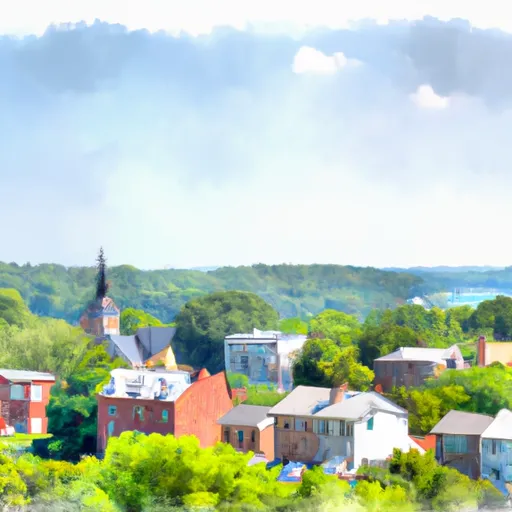-
 Snoflo Premium
Snoflo Premium
Get unlimited access to all our content
With no Ad interruptions! - Start Your Free Trial Login with existing account
West-Friendship
Eden Index
Climate
9.7
•
Recreation
2.8
•
Community
8.5
•
Safeguard
7.0/10

West Friendship is a small town in Howard County, Maryland, known for its picturesque landscapes and close-knit community. The climate in West Friendship is characterized by mild to moderate temperature variations throughout the year. Summers are warm with an average temperature of 85°F, while winters can be chilly with an average temperature of 35°F. The area experiences moderate rainfall evenly distributed throughout the year, which contributes to the hydrology constituents of the region.
West Friendship boasts several outdoor recreational opportunities due to its proximity to the Patapsco Valley State Park and the Liberty Reservoir. The state park offers hiking trails, fishing spots, and picnic areas, providing ample opportunities for nature enthusiasts to explore and appreciate the local flora and fauna. The Liberty Reservoir is a popular spot for boating, fishing, and bird-watching. Additionally, the region is dotted with scenic farmlands and rolling hills, ideal for activities such as horseback riding, cycling, and nature walks. West Friendship provides a serene environment for residents and visitors alike to indulge in various outdoor activities while enjoying the beauty of the Maryland countryside.
What is the Eden Index?
The Snoflo Eden Index serves as a comprehensive rating system for regions, evaluating their desirability through a holistic assessment of climate health, outdoor recreation opportunities, and natural disaster risk, acknowledging the profound impact of these factors on livability and well-being.
Climate Health Indicator (CHI): 9.7
West-Friendship receives approximately
1166mm of rain per year,
with humidity levels near 77%
and air temperatures averaging around
13°C.
West-Friendship has a plant hardyness factor of
6, meaning
plants and agriculture in this region thrive during a short period during spring and early summer. Most
plants will die off during the colder winter months.
By considering the ideal temperature range, reliable water supplies, clean air, and stable seasonal rain or snowpacks, the Climate Health Indicator (CHI) underscores the significance of a healthy climate as the foundation for quality living.
A healthy climate is paramount for ensuring a high quality of life and livability in a region, fostering both physical well-being and environmental harmony. This can be characterized by ideal temperatures, reliable access to water supplies, clean air, and consistent seasonal rain or snowpacks.
Weather Forecast
Streamflow Conditions
Upper Chesapeake
Area Rivers
Upper Chesapeake
Snowpack Depths
Upper Chesapeake
Reservoir Storage Capacity
Upper Chesapeake
Groundwater Levels
Recreational Opportunity Index (ROI): 2.8
The Recreational Opportunity Index (ROI) recognizes the value of outdoor recreational options, such as parks, hiking trails, camping sites, and fishing spots, while acknowledging that climate plays a pivotal role in ensuring the comfort and consistency of these experiences.
Access to outdoor recreational opportunities, encompassing activities such as parks, hiking, camping, and fishing, is crucial for overall well-being, and the climate plays a pivotal role in enabling and enhancing these experiences, ensuring that individuals can engage in nature-based activities comfortably and consistently.
Camping Areas
| Campground | Campsites | Reservations | Toilets | Showers | Elevation |
|---|---|---|---|---|---|
| Andrews AFB Military | None | 269 ft | |||
| Greenbelt Park | 175 | 121 ft | |||
| Pohick Bay Regional Park | 150 | 126 ft | |||
| Smallwood State Park | 15 | 16 ft | |||
| Louise F. Cosca Regional Park | 23 | 223 ft | |||
| Fort Belvoir Travel and RV Camp | 52 | 132 ft | |||
| Cedarville State Forest | 27 | 198 ft |
Nearby Ski Areas
Catastrophe Safeguard Index (CSI):
The Catastrophe Safeguard Index (CSI) recognizes that natural disaster risk, encompassing floods, fires, hurricanes, and tornadoes, can drastically affect safety and the overall appeal of an area.
The level of natural disaster risk in a region significantly affects safety and the overall livability, with climate change amplifying these risks by potentially increasing the frequency and intensity of events like floods, fires, hurricanes, and tornadoes, thereby posing substantial challenges to community resilience and well-being.
Community Resilience Indicator (CRI): 8.5
The Community Resilience Indicator (CRI) recognizes that education, healthcare, and socioeconomics are crucial to the well-being of a region. The CRI acknowledges the profound impact of these elements on residents' overall quality of life. By evaluating educational resources, healthcare accessibility, and economic inclusivity, the index captures the essential aspects that contribute to a thriving community, fostering resident satisfaction, equity, and social cohesion.

